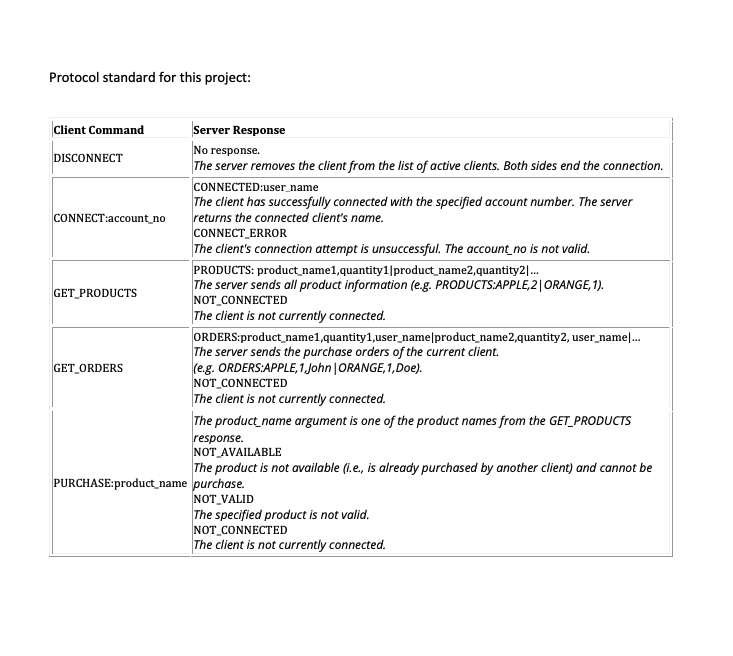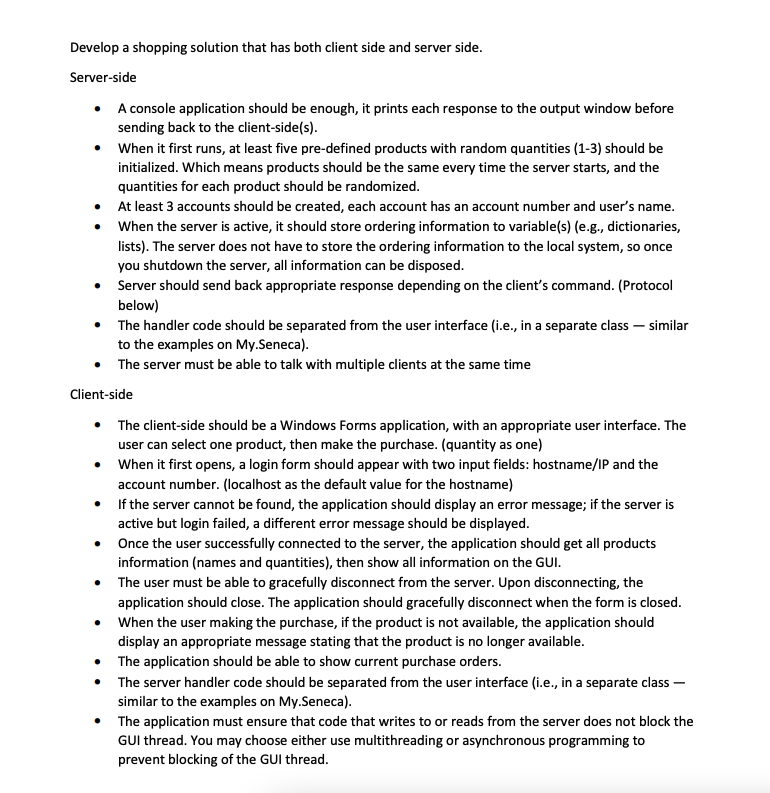Protocol standard for this project: Client Command DISCONNECT CONNECT:account_no GET_PRODUCTS GET_ORDERS Server Response No response. The server removes the client from the list of active clients. Both sides end the connection. CONNECTED:user_name The client has successfully connected with the specified account number. The server returns the connected client's name. CONNECT_ERROR The client's connection attempt is unsuccessful. The account_no is not valid. PRODUCTS: product_name1,quantity1|product_name2,quantity2|... The server sends all product information (e.g. PRODUCTS:APPLE,2 | ORANGE, 1). NOT CONNECTED The client is not currently connected. ORDERS:product_name1,quantity1,user_name|product_name2,quantity2, user_name[... The server sends the purchase orders of the current client. (e.g. ORDERS:APPLE,1,John | ORANGE,1,Doe). NOT CONNECTED The client is not currently connected. The product_name argument is one of the product names from the GET_PRODUCTS response. NOT AVAILABLE The product is not available (i.e., is already purchased by another client) and cannot be PURCHASE:product_name purchase. NOT_VALID The specified product is not valid. NOT_CONNECTED The client is not currently connected. Develop a shopping solution that has both client side and server side. Server-side ⚫ A console application should be enough, it prints each response to the output window before sending back to the client-side(s). • When it first runs, at least five pre-defined products with random quantities (1-3) should be initialized. Which means products should be the same every time the server starts, and the quantities for each product should be randomized. At least 3 accounts should be created, each account has an account number and user's name. • When the server is active, it should store ordering information to variable(s) (e.g., dictionaries, lists). The server does not have to store the ordering information to the local system, so once you shutdown the server, all information can be disposed. • Server should send back appropriate response depending on the client's command. (Protocol below) • The handler code should be separated from the user interface (i.e., in a separate class - similar to the examples on My.Seneca). • The server must be able to talk with multiple clients at the same time Client-side • The client-side should be a Windows Forms application, with an appropriate user interface. The user can select one product, then make the purchase. (quantity as one) • • When it first opens, a login form should appear with two input fields: hostname/IP and the account number. (localhost as the default value for the hostname) If the server cannot be found, the application should display an error message; if the server is active but login failed, a different error message should be displayed. • Once the user successfully connected to the server, the application should get all products information (names and quantities), then show all information on the GUI. • • The user must be able to gracefully disconnect from the server. Upon disconnecting, the application should close. The application should gracefully disconnect when the form is closed. When the user making the purchase, if the product is not available, the application should display an appropriate message stating that the product is no longer available. • The application should be able to show current purchase orders. • The server handler code should be separated from the user interface (i.e., in a separate class- similar to the examples on My.Seneca). • The application must ensure that code that writes to or reads from the server does not block the GUI thread. You may choose either use multithreading or asynchronous programming to prevent blocking of the GUI thread.
Protocol standard for this project: Client Command DISCONNECT CONNECT:account_no GET_PRODUCTS GET_ORDERS Server Response No response. The server removes the client from the list of active clients. Both sides end the connection. CONNECTED:user_name The client has successfully connected with the specified account number. The server returns the connected client's name. CONNECT_ERROR The client's connection attempt is unsuccessful. The account_no is not valid. PRODUCTS: product_name1,quantity1|product_name2,quantity2|... The server sends all product information (e.g. PRODUCTS:APPLE,2 | ORANGE, 1). NOT CONNECTED The client is not currently connected. ORDERS:product_name1,quantity1,user_name|product_name2,quantity2, user_name[... The server sends the purchase orders of the current client. (e.g. ORDERS:APPLE,1,John | ORANGE,1,Doe). NOT CONNECTED The client is not currently connected. The product_name argument is one of the product names from the GET_PRODUCTS response. NOT AVAILABLE The product is not available (i.e., is already purchased by another client) and cannot be PURCHASE:product_name purchase. NOT_VALID The specified product is not valid. NOT_CONNECTED The client is not currently connected. Develop a shopping solution that has both client side and server side. Server-side ⚫ A console application should be enough, it prints each response to the output window before sending back to the client-side(s). • When it first runs, at least five pre-defined products with random quantities (1-3) should be initialized. Which means products should be the same every time the server starts, and the quantities for each product should be randomized. At least 3 accounts should be created, each account has an account number and user's name. • When the server is active, it should store ordering information to variable(s) (e.g., dictionaries, lists). The server does not have to store the ordering information to the local system, so once you shutdown the server, all information can be disposed. • Server should send back appropriate response depending on the client's command. (Protocol below) • The handler code should be separated from the user interface (i.e., in a separate class - similar to the examples on My.Seneca). • The server must be able to talk with multiple clients at the same time Client-side • The client-side should be a Windows Forms application, with an appropriate user interface. The user can select one product, then make the purchase. (quantity as one) • • When it first opens, a login form should appear with two input fields: hostname/IP and the account number. (localhost as the default value for the hostname) If the server cannot be found, the application should display an error message; if the server is active but login failed, a different error message should be displayed. • Once the user successfully connected to the server, the application should get all products information (names and quantities), then show all information on the GUI. • • The user must be able to gracefully disconnect from the server. Upon disconnecting, the application should close. The application should gracefully disconnect when the form is closed. When the user making the purchase, if the product is not available, the application should display an appropriate message stating that the product is no longer available. • The application should be able to show current purchase orders. • The server handler code should be separated from the user interface (i.e., in a separate class- similar to the examples on My.Seneca). • The application must ensure that code that writes to or reads from the server does not block the GUI thread. You may choose either use multithreading or asynchronous programming to prevent blocking of the GUI thread.
Database System Concepts
7th Edition
ISBN:9780078022159
Author:Abraham Silberschatz Professor, Henry F. Korth, S. Sudarshan
Publisher:Abraham Silberschatz Professor, Henry F. Korth, S. Sudarshan
Chapter1: Introduction
Section: Chapter Questions
Problem 1PE
Related questions
Question

Transcribed Image Text:Protocol standard for this project:
Client Command
DISCONNECT
CONNECT:account_no
GET_PRODUCTS
GET_ORDERS
Server Response
No response.
The server removes the client from the list of active clients. Both sides end the connection.
CONNECTED:user_name
The client has successfully connected with the specified account number. The server
returns the connected client's name.
CONNECT_ERROR
The client's connection attempt is unsuccessful. The account_no is not valid.
PRODUCTS: product_name1,quantity1|product_name2,quantity2|...
The server sends all product information (e.g. PRODUCTS:APPLE,2 | ORANGE, 1).
NOT CONNECTED
The client is not currently connected.
ORDERS:product_name1,quantity1,user_name|product_name2,quantity2, user_name[...
The server sends the purchase orders of the current client.
(e.g. ORDERS:APPLE,1,John | ORANGE,1,Doe).
NOT CONNECTED
The client is not currently connected.
The product_name argument is one of the product names from the GET_PRODUCTS
response.
NOT AVAILABLE
The product is not available (i.e., is already purchased by another client) and cannot be
PURCHASE:product_name purchase.
NOT_VALID
The specified product is not valid.
NOT_CONNECTED
The client is not currently connected.

Transcribed Image Text:Develop a shopping solution that has both client side and server side.
Server-side
⚫ A console application should be enough, it prints each response to the output window before
sending back to the client-side(s).
•
When it first runs, at least five pre-defined products with random quantities (1-3) should be
initialized. Which means products should be the same every time the server starts, and the
quantities for each product should be randomized.
At least 3 accounts should be created, each account has an account number and user's name.
• When the server is active, it should store ordering information to variable(s) (e.g., dictionaries,
lists). The server does not have to store the ordering information to the local system, so once
you shutdown the server, all information can be disposed.
• Server should send back appropriate response depending on the client's command. (Protocol
below)
• The handler code should be separated from the user interface (i.e., in a separate class - similar
to the examples on My.Seneca).
• The server must be able to talk with multiple clients at the same time
Client-side
• The client-side should be a Windows Forms application, with an appropriate user interface. The
user can select one product, then make the purchase. (quantity as one)
•
•
When it first opens, a login form should appear with two input fields: hostname/IP and the
account number. (localhost as the default value for the hostname)
If the server cannot be found, the application should display an error message; if the server is
active but login failed, a different error message should be displayed.
• Once the user successfully connected to the server, the application should get all products
information (names and quantities), then show all information on the GUI.
•
•
The user must be able to gracefully disconnect from the server. Upon disconnecting, the
application should close. The application should gracefully disconnect when the form is closed.
When the user making the purchase, if the product is not available, the application should
display an appropriate message stating that the product is no longer available.
• The application should be able to show current purchase orders.
• The server handler code should be separated from the user interface (i.e., in a separate class-
similar to the examples on My.Seneca).
• The application must ensure that code that writes to or reads from the server does not block the
GUI thread. You may choose either use multithreading or asynchronous programming to
prevent blocking of the GUI thread.
AI-Generated Solution
Unlock instant AI solutions
Tap the button
to generate a solution
Recommended textbooks for you

Database System Concepts
Computer Science
ISBN:
9780078022159
Author:
Abraham Silberschatz Professor, Henry F. Korth, S. Sudarshan
Publisher:
McGraw-Hill Education

Starting Out with Python (4th Edition)
Computer Science
ISBN:
9780134444321
Author:
Tony Gaddis
Publisher:
PEARSON

Digital Fundamentals (11th Edition)
Computer Science
ISBN:
9780132737968
Author:
Thomas L. Floyd
Publisher:
PEARSON

Database System Concepts
Computer Science
ISBN:
9780078022159
Author:
Abraham Silberschatz Professor, Henry F. Korth, S. Sudarshan
Publisher:
McGraw-Hill Education

Starting Out with Python (4th Edition)
Computer Science
ISBN:
9780134444321
Author:
Tony Gaddis
Publisher:
PEARSON

Digital Fundamentals (11th Edition)
Computer Science
ISBN:
9780132737968
Author:
Thomas L. Floyd
Publisher:
PEARSON

C How to Program (8th Edition)
Computer Science
ISBN:
9780133976892
Author:
Paul J. Deitel, Harvey Deitel
Publisher:
PEARSON

Database Systems: Design, Implementation, & Manag…
Computer Science
ISBN:
9781337627900
Author:
Carlos Coronel, Steven Morris
Publisher:
Cengage Learning

Programmable Logic Controllers
Computer Science
ISBN:
9780073373843
Author:
Frank D. Petruzella
Publisher:
McGraw-Hill Education